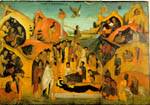|
|
| Portable Icons |
mid-15th c. Iviron Monastery Wood, egg tempera, 56 x 37 cm Cretan School |
|

|
In the centre of the icon, against a backdrop of gentle hills and caves, stands a group of monks lamenting over the mortal remains of St Ephraim. The saint has been wrapped in a monk's habit and laid on a low slab, with an icon on his chest. Around him stands a dense semicircle of grieving monks. Some bend to give him the last kiss and a priest swings a censer as he prepares for the burial. A monk in the background strikes the semantron, in accordance with the rule, to announce the saint's death to the hermits and summon them to the funeral. They are depicted in rocky caves, praying, working, or studying. One of them is shown sitting on a pillar receiving a basket of food. Other hermits, old, ill, or infirm, are being accompanied to the funeral: one on a donkey, another on a lion, another on a litter carried by two monks; one even crawls on his knees. In the upper part of the icon, the bust of an angel is shown carrying the saint's soul heavenward. The landscape, which consists of soft, almost three-dimensional, hills and caves with pointed roofs, is scattered with bushes, pines, and animals, such as the two hares on the left sitting beside a cluster of low trees. Behind the monk with the semantron, a western-style landscape with the walls of a township discreetly unfolds in the distance. As the subject is described and analysed by Markos Eugenikos in the fifteenth century, the representation in the Iviron icon, with its several discrete scenes and multi-level landscape, seems to be based on an iconographical prototype which appeared fully developed in the thirteenth century and was supplemented in the Palaeologan period with various picturesque details (Martin 1954, pp. 217-25. Chatzidakis 1974 (2), pp. 189-92. Acheimastou-Potamianou 1991, I, pp. 41-5). The most representative examples of the type are seen in portable icons of the fifteenth-century Cretan School, thanks to which the theme became especially popular in monumental painting, particularly that of the sixteenth-century Cretan School (Chatzidakis 1974 (2), p. 191, pl. ΚΔ΄. Acheimastou-Potamianou 1991, pp. 44-6). The Iviron icon is part of this Cretan-School group, but, in comparison with other icons of the same type, the iconographical format here is simpler. In this respect it more closely resembles the icon in the Patriarchate of Constantinople (Soteriou 1938, pl. 21), which lacks the picturesque details of flora and fauna found in other icons, such as gazelles, a lake with birds in the foreground, and a stream flowing from the rocks. Another detail that distinguishes it from other icons of the same subject is the distant landscape with the walled township, which discreetly reflects a western perception of spatial perspective (see also the icon in Worcester, Martin 1954, fig. 3). It should also be noted that the synthetic conception, which is sparse not dense, and the structure and form of the rocky landscape with the soft hills and the harmonious range of colour tones which are very close to Palaeologan models, again have a parallel in the icon in the Patriarchate of Constantinople. From a technical and stylistic point of view, the figures are tall, with mature modelling, sensitive outlines, and simple drapery that has a close organic relationship to the body beneath. The faces are rendered with soft, painterly modelling and with bright, limited spots of highlighting. This soft, resilient effect, which has its origins in early fifteenth-century Palaeologan icons (Chatzidakis 1977, pls. 8-9), also characterises the Dormition of St Ephraim in the Patriarchate of Constantinople and in the Byzantine Museum in Athens, which are dated to the first half and the middle of the fifteenth century respectively (Soteriou 1938, p. 32. Acheimastou-Potamianou 1991, p. 54). This writer therefore believes that the Iviron icon, which reveals artistic links with trends in the Palaeologan painting of the fifteenth century, though without the academic aspect that appears in late works at the end of the fifteenth century, may be dated to the middle of the fifteenth century.
| |
|
Bibliography: Chatzidakis 1974 (2), pp. 189-92, pl. ΚΓ΄.1.
| ||
| E.N.T. | ||
| Index of exhibits of Monastery of Iviron 15th century |
||
Reference address : https://www.elpenor.org/athos/en/e218ab33.asp